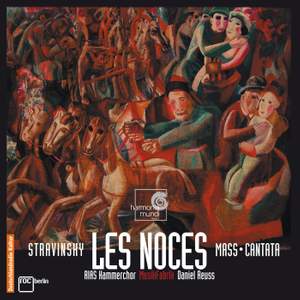Stravinsky: Les Noces, Mass & Cantata
Carolyn Sampson, Susan Parry, Jan Kobow, Vsevolod Grivnov & Maxim Mikhailov
RIAS-Kammerchor, MusikFabrik & Ensemble für Neue Musik, Daniel Reuss
Stravinsky loathed superimposed 'expressiveness', and always insisted his music should be executed rather than interpreted. On that basis, this latest release from the RIAS Chamber Choir of... — More…
-
Gramophone MagazineSeptember 2006Editor's Choice
Downloads
What are FLAC and MP3?Contents
Stravinsky: Les Noces
Work length24:38
$4.40
$5.50
Premier tableau: Chez la mariée
Track length5:09
$1.00
$1.25
Deuxième tableau: Chez le marié
Track length5:45
$1.00
$1.25
Troisième tableau: Le départ de la mariée
Track length3:00
$1.00
$1.25
Quatrième tableau : Le repas de noces
Track length10:44
$1.40
$1.75
Stravinsky: Messe
Work length17:44
$5.00
$6.25
Kyrie
Track length2:29
$1.00
$1.25
Gloria
Track length3:43
$1.00
$1.25
Credo
Track length4:27
$1.00
$1.25
Sanctus
Track length3:39
$1.00
$1.25
Agnus Dei
Track length3:26
$1.00
$1.25
Stravinsky: Cantate
Work length23:57
$7.40
$9.25
I. A lyke-wake dirge. Versus 1. Prelude - This ae nighte
Track length1:43
$1.00
$1.25
II. Ricercar I. The maidens came
Track length3:50
$1.00
$1.25
III. A lyke-wake dirge. Versus 2. First interlude - If ever you gav'st hos'n and shoon
Track length1:42
$1.00
$1.25







